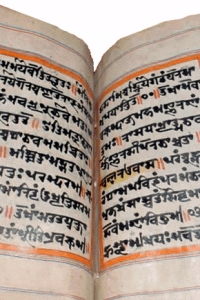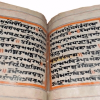
The ancient Indian literature is the glorious gift of the Indian civilization to the world. It comprises of the illustrious scriptures. The Indian scriptures can be broadly classified into two categories:
(1) The Shruti literature (2) The Smriti literature.
Shruti is concerned with ‘the heard’ or ‘the revealed’. Smriti is concerned with ‘the remembered.’
The Vedas and the Upanishads are considered as the Shruti literature. The Sanskrit root ‘shrut’ means ‘to hear’. In ancient times, while doing their tapasya and sadhana, the great sages ‘heard’ the divine truths. Whatever was ‘heard’ was presented in the Vedas and the Upanishads. Thus they came to be known as the Shruti literature.
Smriti literature is concerned with ‘that what is remembered’. The literature which was based on the knowledge acquired through the experience or the tradition was the Smriti literature.
Generally, the Smriti literature is based on the Shruti. The famous Manu-Smriti and other smritis and shastras constitute the Smriti literature. The guidelines for ethics, moral obligations, social codes, customs etc. are found in the Smriti literature. The great epics Mahabharata and Ramayana also belong to the Smriti literature.
While the Shruti literature is veritable and inviolable, the Smriti literature may get modified under the influence of time and place.
The Vedas represent the most sacred heritage of the mankind.
The Vedas reflect the growth and development of human thought over a span of scores of centuries. They vividly present a picture of the transformation of a prakrit man into a sanskrit man.
The Vedas are regarded as divine in origin. They are referred to as apaurusheya. They are not produced by a couple of individuals. They are not composed by some poets or authors. The Vedas constitute the sublime knowledge revealed to our great ancestors while they were doing their penance. It is not an acquired knowledge. It is the sublime knowledge revealed to them in their meditation by the Supreme Divinity. The ancient sages, while doing their tapasya and sadhana, ‘heard’ the divine truths. Whatever was ‘heard’ or ‘revealed’ to the great sages was presented in the Vedas and the Upanishads.
The Vedas are eternal. They are timeless. They are without a beginning. They were not composed at a certain time. No doubt, they might have acquired the verbal form during certain period in history. They are timeless in the sense that they are beyond the confines of time. They are the eternal truths beyond the influence of time. Time or place can not affect the significance of the knowledge ‘contained’ in the Vedas.
The Vedas are divine and eternal. The Vedas are truly considered to be the boundless repository of “knowledge par excellence”.
The Vedas are known as the Shruti literature.
The Shruti is treated as the supreme and ultimate authority. The authentic Smriti literature has had its basis in the Shruti. Whenever a difference arises between the Shruti and the Smriti, the Shruti statement is accepted as the final word. Needless to say, the Smriti is to be interpreted in consonance with the Shruti. From time to time the Smriti might undergo modifications, but the Shruti cannot be altered at all.
The ancient Rishis led a very pious life which was further sanctified by the austerity of penance. They could ‘hear’ the silence of the Divinity and could ‘see’ the Infinite. The Vedic Rishi is referred to as a drashta or a seer. The Vedic Rishis could ‘see’ even the transcendental truth as they were great ‘seers’. The ‘divine truths’ were revealed to them while they were in meditation on higher spiritual planes. The Vedas contain the ‘divine knowledge’ revealed to the great Rishis in their “Supra-normal Consciousness”, as Shri Aurobindo says.
The Vedas present the sublime form of knowledge. This knowledge is impersonal. It is divine. It is absolute, veritable and inviolable. It is eternal; it is timeless. It remains unaffected at all times, at all places, under all circumstances. Hence the Vedas are adjudged the Swatah Pramana or self-evident. That means their truths do not need any proof, support or elaboration.
The Vedas encompass the human life. They do not belong to a particular religion or a race or a country. They are the holy scriptures of Hinduism, but they equally belong to the human race. Dr. Radhakrishnan refers to the Vedas as, "the earliest documents of the human mind."
What do the Vedas contain?
The Vedas contain the mantras. These mantras have specific purposes.
Most of them are symbolic. Some of them are hymns addressed to the deities. Some of them are for ceremonial purposes or for the rites and rituals. Some deal with the social life. There are references to the sciences and mathematics also. Discussions on the topics of chemistry, astronomy, botany, zoology, physiology, medical therapeutics and bio-sciences are also found in the Vedas.
The Vedas reflect all the aspects of existence. They throw light on the Srishti (the creation), the Brahman, the atman, the life and all the related issues of spiritualism. The Vedas present a record of the philosophical progress of man.
However it should be remembered that neither the Vedas nor the Upanishads propagate a specific ideology or a doctrine. As such they are not philosophical treatises. Yet one finds ample evidence of subtle philosophical thoughts from the verses.
In the Vedas, several portions are repeated in toto. A large number of mantras are found to be repetitious. It may be noted that the chapters or the mantras are not sequential. The ideas and thoughts in a single chapter may seem to be illogical or incoherent. There are instances of unexplainable digressions from a theme within a chapter. Hence one may not find a systematic, logical development of a doctrine. However, it does not undermine the significance of the Vedas.
A great deal of scholastic ability is required to interpret the Vedas. A single word may have different meanings in different contexts. Many mantras are cryptic statements to a lay man. Some of them are too enigmatic to be followed. They are ambiguous or symbolic.
This is why the Vedas have often been misinterpreted even by learned scholars of reputation. Unfortunately, some of the Western philosophers have not done justice to the Vedas. Many of them failed to understand them correctly and presented distorted views on several counts. Some of the Indian scholars have been influenced by their Western counterparts.
On the other hand, Dayananda Saraswati, Shri Aurobindo and others have challenged the Westerners and made great efforts to re-evaluate the Vedas. One may now remember that the Vedas could only be interpreted with the help of an elaborate explanation by an expert. Once understood thoroughly, they open up new vistas of knowledge and radically transform life.
The meaning of the word ‘Veda’
The word ‘Veda’ is interpreted in more than one ways by different scholars. Swami Dayananda Saraswati has brought out four diverse meanings of the word. Thus, the word ‘Veda’ can be defined in more than one ways.
The word ‘Veda’ originates from the Sanskrit root Vid. The Sanskrit verb ‘Vid’ means ‘to know’. The word ‘Veda’ literally means knowledge. The Veda is concerned with “knowledge par excellence”. When the man was in a primitive stage enveloped in darkness, the philosophy of the Veda was the unprecedented glow of knowledge. The knowledge which transformed a prakrit man to a Sanskrit man is the Veda.
The word ‘Veda’ means ‘to be’. It is concerned with astitva - the existence. That which creates awareness in a man about his own existence is the Veda.
One of the interpretations of the word ‘Veda’ is ‘to think’. The word ‘Veda’ is suggestive of ‘thought’. Thinking awakens discretion in a man’s mind. It makes a man wise and judicious. The knowledge which helps to distinguish between Sat and Asat is the Veda.
The word ‘Veda’ also refers to accomplishment. The knowledge which helps a man in realizing his supreme goal is the Veda.
Shri Veda Vyasa (also known as Badarayana or Krishna Dvaipayana Vyasa) was one of the greatest of all the sages of India.
His contribution in compilation of the Vedas is an example of unparalleled erudition. With great perseverance, he searched for all the work of the Rishis. He collected all the mantras and categorized them.
The mantra which is in the metered form and recited for the praise of the deity is called rik or richa. The mantra that can be chanted melodiously is called sama. The mantra in the prose form is called yajus. The mantra meant for daily rites and rituals in prose or poetic form is known as atharva.
Thus Veda Vyasa categorized all the mantras and compiled them in four parts. The four parts thus compiled came to be known as the four Vedas.
The four Vedas are the Rig Veda, the Yajur Veda, the Sama Veda and the Atharva Veda.
The Rig Veda is the oldest of all the Vedas. The Rig Veda is composed of 10552 mantras. It is believed to be the work of 403 sages. The person who knows all the mantras is known as Ritwik.
The Yajur Veda is the smallest of all the four Vedas. The knower of this Veda is known as Adhvaryu.
The Sama Veda has 1875 mantras. The knower of this Veda is known as Udgata.
The Atharva Veda has a special place in the field of philosophy and spiritualism. The knower of this Veda is known as Brahma.
In simple terms, the Vedas are the compilation of the mantras or the hymns. The word ‘mantra’ originates from the Sanskrit word ‘manan’ which suggests ‘thinking’, ‘pondering’ or ‘contemplating’. Most of the mantras are in the form of the metered verse.
Originally, the Vedas were not in a written form. In the early years, they were chanted orally. For centuries together, they were transmitted orally to the successive generations. They have been preserved by accurate verbal transmission in the Guru-Shishya tradition and are passed from a generation to the next one. The Vedas acquired the written form hundreds of centuries later.
In order to study the Vedas in details, six shastras are helpful. These shastras are known as the Vedangas. The six Vedangas are: Shiksha, Kalp, Vyakaran, Nirukta, Jyotish and Chhanda.
The Vedas are voluminous literary work. In the formative phases, they have never had been in written form. The scholars differ on the issue of “parts” or the "sections" of the Vedas.
In the opinion of some scholars, the Vedas are constituted of two parts: The Samhitas and the Brahmanas. Other scholars opine that each of the Vedas is divided into four parts (or the sections): the Samhitas, the Brahmanas, the Aranyakas and the Upanishads.
The Samhitas and the Brahmanas form the Karma-Kanda segment of the Vedas. They are apparently concerned with the ceremonial rites and rituals. The Aranyakas and the Upanishads form the Gyan-Kanda segment of the Vedas. They explicitly focus on the philosophy and spiritualism.
The Samhitas
The Samhitas form the first part of each of the Vedas. A Samhita is a collection of mantras, so the Samhitas are sometimes also referred to as the ‘mantras’. Most of the mantras or hymns were concerned with the nature and the deities. The ancient man worshipped the elements of nature as deities though it is believed that these deities are symbolic.
Generally, the mantras are addressed to the Gods and Goddesses. Some Western scholars believe that the Vedic man used the mantras in sacrificial ceremonies and for performing mystic rituals. This may be true for a number of mantras. Apparently, many mantras or hymns were meant for devotional or ceremonial purposes. In fact, they seem to be symbolic and need exceptional scholastic efforts to decipher them.
Swami Dayananda Saraswati made extraordinary efforts to bring out the significance of the mantras of the Vedas. Shri Aurobindo also challenged the Western philosophers and opined that the mantras are found to express esoteric truths which the Westerners can not grasp. He strove hard to elucidate the cryptic meanings of the Vedic words and the hymns.
The Samhitas are named after the Vedas they belong to. For example, the Samhita of the Rig Veda is called the Rig-Veda-Samhita or the Rig-Samhita.
The Rig-Samhita contains the mantras or the hymns known as ‘richas’. These hymns are metered verses. The Sam-Samhita contains mantras in the form of songs meant for liturgy or public worship. The Yajur-Samhita contains verities of mantras composed in the poetical and the prose forms. The Atharva-Samhita contains mantras meant for routine rites and rituals.
The Brahmanas
The Brahmanas constitute the second part of the Vedas.
With the passage of time, the newer generations found the mantras of the Samhitas difficult to understand. An elaborate explanation of the mantras became necessary. The result was the Brahmanas. The Brahmanas are explanatory in nature.
The Brahmanas, the second part of the Vedas, are mostly in prose. The word ‘Brahmana’ has its root in the word ‘brahman’ which means ‘prayer’ or ‘devotion’. The word ‘brahman’ is distinct from the word ‘Brahman’ which means ‘the immanent Power’. The Brahmanas hint at ‘the magic’ or ‘the secret power’ of the sacrificial rituals.
The Brahmanas are concerned with the religious rites and rituals. But their covert meanings often baffle the researchers. The Indian scholars differ from their Western counterparts.
The Rig Veda has two Brahmanas – Aitereya Brahmana and Shankhayana Brahmana.
The Shat-Patha Brahmana of Yajur Veda is the largest of all the Brahmanas of all the Vedas.
The Aranyakas
The Aranyakas form the third part of the Vedas. However, it should be noted that the Aranyakas are sometimes considered as parts of the Brahmanas.
The Sanskrit word ‘aranya’ means a forest.
The Aranyakas were developed by the hermits, living in the forests. Due to the limited resources in the forests, they could not perform the conventional sacrifices, nor could they adhere to the rituals. It was then that the Aranyakas were developed.
With the advent of the Aranyakas, the emphasis on the sacrificial rites seemed to be diluting. The shift towards philosophic and spiritual interpretation of the rituals and ceremonials is evident.
The Aranyakas reflect an explicit transition in the philosophy of life of man. The speculative and intuitive thinking seems to be developing. Meditative thinking is conspicuous. The Vedic man seems to be turning from the gross to the subtle. His quest for knowledge seems to be intensified.
The Upanishads
The Upanishads are the concluding portions of the Vedas. The Upanishads are at the end of the Vedas.
The Upanishads are referred to as the Vedanta. The word Vedanta is a compound word made up of two Sanskrit words: ‘Veda’ and ‘Anta’. The word ‘anta’ means an end. The Vedanta essentially refers to the philosophy pronounced in the Upanishads, the final parts of the Vedas. The Vedanta broadly covers the philosophy enunciated by the holy Scriptural Trinity – the Upanishads, the Brahma-Sutra and the Bhagavad Gita.
Some scholars consider the Upanishads as the extended portions of the Aranyakas or the Brahmanas. For e.g. Brihdaranyaka Upanishad is considered to be the final chapter of the Shat-Patha Brahmana. Some scholars treat the Vedas and the Upanishads altogether separately.
The word ‘Upanishad’ is derived from the Sanskrit root ‘Sad’. The Sanskrit verb sad refers to the knowledge or the satya. The words ‘upa’ + ‘ni’ suggests ‘sitting (before someone) with a determination’. The word ‘Upanishad’ can be understood as: To sit near (close to) a guru with an objective to acquire knowledge.
Most of the Upanishads are in forms of dialogues between a master and a disciple. In Upanishads, a seeker raises a topic and the enlightened guru satisfies the query aptly and convincingly. Thus, the Upanishads contain the sublime knowledge that deals with the topic at great depth. The Upanishads enrich the human mind immensely as they discuss the Brahman, the atman, the existence, life and death, moksha(mukti), the jagat, the knowledge (the para-vidya and the apara-vidya), the Brahma-gyana (or the atma-gyana) and many other related issues elaborately.
It is not known how many Upanishads existed originally. We do not know who composed them. Some of the Upanishads are in the prose form and some others in the verse form. Some of them are partly composed in prose and partly in verse. Some of the Upanishads have been composed in recent times. It is difficult to ascertain the precise number of the original, ancient Upanishads. One hundred and eight Upanishads are believed to belong to the ancient times. Of the 108 Upanishads, ten Upanishads are considered exquisite by distinguished scholars.
The ten outstanding Upanishads are:
Isha, Kena, Katha, Prashna, Mundaka, Mandukya, Chhandogya, Brahadaranyaka, Aitereya and Taitteriya.
Some scholars also attach due importance to Shvetashvatara and Maitri. Some others opine that even Kautishaki is equally valuable.
It is believed that the Rig Veda has 10 Upanishads. The number of Upanishads for Shukla Yajur Veda is 19, for Krishna Yajur Veda 32 and for Sama Veda it is 16. Atharva Veda has 31 Upanishads.
Aiteriya Upanishad is associated with Rig Veda. Kena Upanishad is associated with Sama Veda.
Isha Upanishad is a part of Shukla Yajur Veda. Katha Upanishad is associated with Krishna Yajur Veda.
Prashna Upanishad is associated with Atharva Veda.
The most exalted Rishis and the enlightened celebrities have contributed to the Upanishads. Some of them are Maharshi Yagnavalkya, Rajarshi Janak, Mandukya Muni, Pippalad Muni etc. Maharshi Yagnavalkya contributed significantly to the Brahadaranyaka Upanishad.
About the Author





Comments